by Tom Gaylord
Writing as B.B. Pelletier
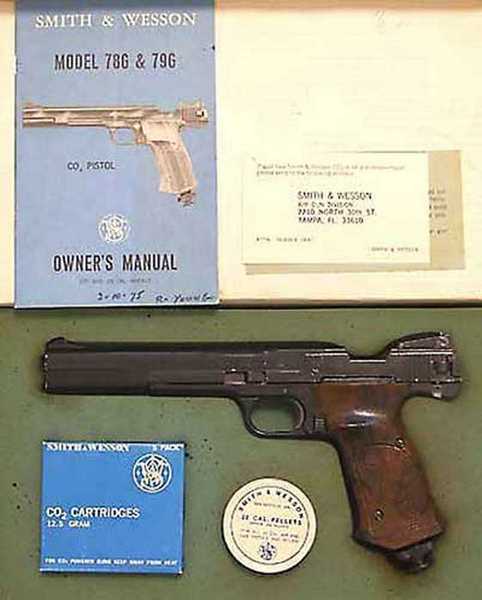
My S&W 78G pistol.
This report covers:
- Something special
- Velocity
- RWS Hobby
- Shot count
- Little trick
- 12.5-gram CO2 cartridges
- Crosman Premiers
- H&N Baracudas
- Trigger pull
- Discussion
- Summary
Something special
Before we begin let me remind all of you that today is the 3rd of June — another sleepy dusty delta day. Stay away from Choctaw Ridge!
The comments to Part 1 of this report show that there are many airgunners who appreciate these air pistols. I mentioned in Part 1 that after 1980, Daisy took over the manufacture of these pistols and designated them models 780 and 790. In 1984 they brought out the silver-colored Daisy model 41 that was made only in that year. According to the Blue Book of Airguns the 780 was made from 1982 to 1983. The 790 was made from 1982 to 1988.
One of our readers — 45Bravo — reseals these guns, as long as they haven’t been modified or “customized.” He knows the S&W and the Daisy guns quite well, and he is working on a guest blog to tell us the differences between them. I have already learned some things just by reading the draft of his report. There isn’t a lot of information available on the Daisy guns, so this series will be of value to everyone who is interested in these airguns.
Velocity
Today we will look at the velocity of my 78G, which is the .22 caliber version of the pistol. I mentioned in Part 1 that my pistol has been modified, so don’t compare it to a stock 78G. Mine shoots a lot faster and gets fewer shots on a CO2 cartridge. The man who did the work on this one no longer works on them, as far as I know, but from what I’m reading while researching, they aren’t that hard to reseal, as long as they haven’t been modified.
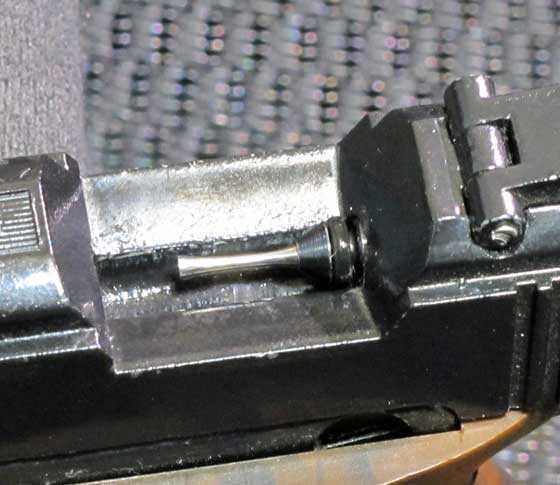
Part of the soup-up was to thin and shape the normally fat rounded bolt probe. This allows better gas flow.
RWS Hobby
I’ll start with a known lightweight lead pellet — the RWS Hobby wadcutter. At just 11.9-grains, you know this one will be fast in any pellet gun. In the 78G Hobbys average 521 f.p.s. for the first 10 shots. I would expect a stock pistol to shoot them at 375-395 f.p.s. My pistol is definitely fast.
The velocity spread ranged from a low of 511 to a high of 529 f.p.s. That’s a range of 18 f.p.s. which isn’t terrible for a souped-up gas gun. At the average velocity this pellet produced 7.17 foot-pounds at the muzzle.
Shot count
But wait — there’s more! I remembered that this pistol had around 15 good shots on a CO2 cartridge, so I continued shooting Hobbys, to see what they might do. The second string (shots 12 through 22 because there was one shot that did not register in both strings) averaged 510 f.p.s. But let’s look at the string to see what’s really happening. Since I fired 11 shots in the first string, I will start this one with shot 12.
Shot……..Velocity
12………….523
13………….519
14………….510
15………….Did not register
16………….515
17………….508
18………….518
19………….512
20………….505
21………….501
22………….492
That string shows that the power is dropping by shot numbers 20 or 21. Therefore I say there are 20 good shots in a CO2 cartridge. Now, cartridges do vary, so you may get a few more or a few less shots, depending on the cartridge. But I’m going to do something I have never done before. I will shoot this cartridge empty.
Shot……..Velocity
23………….481
24………….472
25………….461
26………….447
27………….438
28………….422
29………….407
30………….388
31………….369
32………….346
33………….325
34………….297
35………….272
36………….235 all the gas exhausted
There you go. Know what we have there? We have the difference in the shot count between BB Pelletier, who is looking for a very tight spread because he shoots at bullseyes, and Joe Average, who just keeps shooting as long as there is gas in the gun! BB says there are 20-21 shots in a cartridge and Joe says there are a good 35. They are both right, according to their own criterion.
I will say that by shot 25 I could hear the difference in the loudness of the shot. So I knew the pressure was dropping.
Little trick
I’ll tell you another reason for continuing to shoot this airgun. Because the designers placed the O-ring on the gas cap where it’s under pressure, the gas cap will be difficult to remove until near the end of the gas. That’s because the o-ring under pressure will hold the gas cap tight. You will even see plier marks on the knurling of some gas caps because of this.
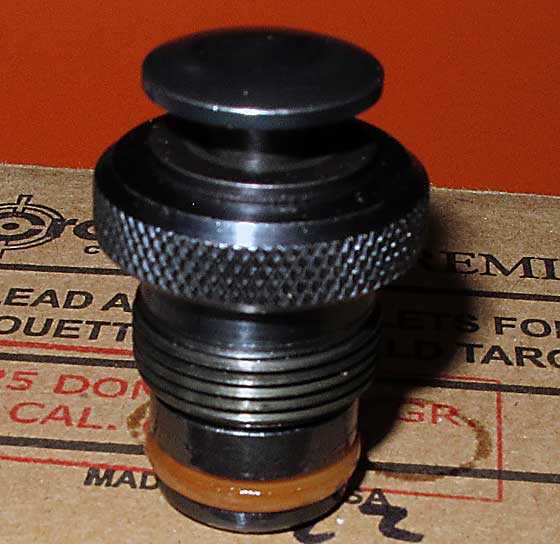
That o-ring was cream-colored when it was installed, but years of exposure to Crosman Pellgunoil has colored it reddish. When it’s under pressure it climbs out of its seat and presses tight against the inside of the pistol grip to seal the gas reservoir.
But that is unnecessary! When the gas pressure gets so low that you can hear the difference, you can exhaust the rest of it by pressing back on the cocking knobs — the reverse direction of how the gun is cocked. Then, if the o-ring material in the o-ring that seals the gas cap is correct, the cap will unscrew easily. If the material in the o-ring is incorrect (a hardware store o-ring, for example), it may have absorbed some of the gas under pressure and you may have to wait a couple hours for the gas to leak out before the cap can be unscrewed. The gas depressurization procedure is spelled out in the owner’s manual.
12.5-gram CO2 cartridges
I used to get criticized for writing that CO2 cylinders contained 12.5-grams of CO2. But back in the 1970s, some cartridges were actually listed that way. They probably held the same amount as cartridges do today — that was just what was on the box.
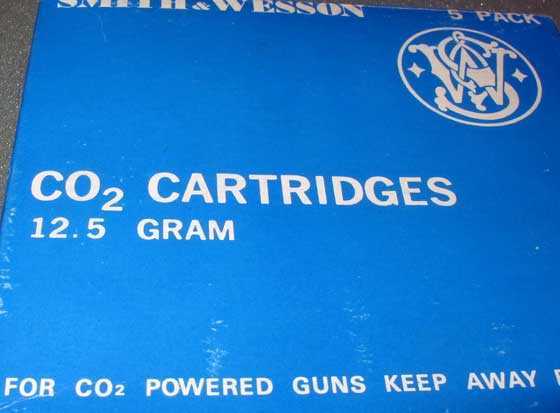
Yep — 12.5 gram cartridges.
And, speaking of things I used to get criticized for, how about my telling people to leave their guns under pressure went stored? Let’s read from the S&W manual.
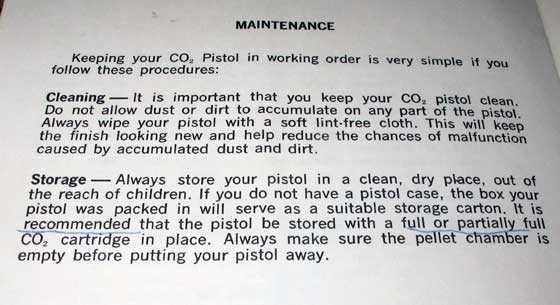
There it is in print. The underlining was done by a previous owner.
Crosman Premiers
Okay, we have seen the velocity with lightweight pellets; what about medium-weights? What will the pistol do with 14.3-grain Crosman Premiers? Well, Premiers averaged 480 f.p.s. The low was 464 and the high was 484 f.p.s. At the average velocity this middleweight pellet develops 7.32 foot-pounds at the muzzle. We expect something like that because pneumatics and gas guns will generate more power with heavier pellets.
H&N Baracudas
Now for a heavyweight. The H&N Baracuda pellet weighs 21.14 grains. It averaged 397 f.p.s. for 10 shots, but remember — this was the second string of 10 fired on a CO2 cartridge. Shot number 1 went out at 412 f.p.s and shot 6 went out at 404 f.p.s. After that the gun never shot over 400 f.p.s. again. So the average would probably by around 406 f.p.s. if I tested the first 10 after installing a fresh cartridge. Not a big deal, but I thought you should know
I calculated the power based on 397 f.p.s. and got an energy of 7.4 foot-pounds. The relationship between pellet weight and energy held through all testing, but with this pistol all the pellets were very close.
Trigger pull
The non-adjustable trigger breaks at 3 lbs., even. There is some travel before the break, but it’s not a bad trigger.
Discussion
Personally I would prefer to have a pistol that’s rated at the standard power. Then there would be a lot more shots on a cartridge. I would also like a pistol with an adjustable trigger, because as I remember it, that was a very crisp and light trigger — almost Crosman Mark I-like. Maybe I will start looking for an early 79G, because I can’t remember ever owning one of them.
Summary
The Smith & Wesson air pistols are classics through and through. If a company today wanted to focus on a landmark design, they could do no better.

BB,
I like that little trick with the loading probe. It makes it more “delicate”, but I can see where it would really improve gas flow.
RR,
It really does! I’ve seen it work on other pneumatic and gas guns, too.
B.B.
BB,
I may have to take a good look at my HM1000X and the 101 I am rebuilding. Every little bit can help.
BB
Well sure it does. That goes back to what I mentioned over the weekend to reader Grandpa Dan when he mentioned he can’t get a PCP gun to fill. Same applies to slow leakers. The bolt pushes the striker or hammer against the valve stem and releases pressure depending on how a gun is set up. So air is always leaking and the gun won’t accept a charge.
What your saying is in reverse. Your creating the leak at the valve to release pressure.
GF1,
Huh? We are talking about bolt probe here — not a striker. This gun cocks via a separate system that has no contact with this bolt.
B.B.
BB
Ok I see I should of said cocking knob not bolt.
B.B.,
I see a future article regarding tricks done to enhance/soup up performance of CO2 powered airguns.
Siraniko
Siraniko,
I don’t know if I am the right guy for that one. Others know so much more than I do.
B.B.
These are great air pistols. I enjoy my 78G and both of my 79Gs along with my Crosman Mark 1 & 2. Like the manual says, I leave the CO2 cartridge with some remaining CO2 in it in the gun. I’m not an excellent pistol shooter, so I can’t really say that the .22s are more accurate than the .177s in either the Crosman or the Smith & Wessons. If I really had to pick the most accurate one of the five above pistols, I would choose the Mark 1, but I don’t often shoot at paper targets except to adjust sights. Targets of opportunity are in trouble with any one of the above five pistols.
As far as resealing the guns, I resealed all three S&Ws and the Mark 2. They are all easy to reseal with the S&W slightly easier in my opinion. I even resealed one of the S&W and the MK 2 exhaust stem (poppet) seals.
“And, speaking of things I used to get criticized for, how about my telling people to leave their guns under pressure when stored?”
B.B., I have always followed your advice on this. And Rick, at Precision Pellet, said the same thing; older, sturdy, CO2 guns such as this S&W model 78, or the Crosman model 38, should be stored under pressure…but not out in the non-air-conditioned garage in the summertime. =>
Dave,
Rick is the one who told me, too.
B.B.
Thanks, B.B. …the airgun community…”It’s a small world, after all.” =D
BB
We have two different methods of utilizing CO2. In one the CO2 cartridge is not tightened down and the other type is.
One should be kept pressurized like a PCP and the other not.
The pistols that utilize an ‘O’ ring sealed cap puncture the cartridge after it is already installed using a lever or push button to puncture it and the CO2 escapes into the cartridge housing cavity. At that point it is exactly like a PCP in operation and should have pressure in it to prevent the seals from shrinking up and leaking over time. And I may have trouble with mine thinking about that.
The other one pushes the CO2 cartridge down onto a seal at the neck and punctures it as it’s tightened. The CO2 remains inside the cartridge. This type should not be left with a CO2 cartridge installed under pressure because it is crushing and distorting the seal material.
If I remember right the Plainsman and Crosman Mark I even have the CO2 cartridge installed upside down because the puncture pin is in the cap and needs to be operated separately from the cartridge installation.
Bob,
According to Rick Willnecker, the only guns that should not be left pressurized are those that have pipes for the gas. Some modern airguns are made so pressure strains their parts.
As for seals, I have left my face-sealer guns pressurized for years without a problem that I know of.
B.B.
BB
I don’t ever recall the word ‘Pipes’ being used in reference to airguns. You got me there.
Are you talking about the thin tubes that hold the cartridges under the barrel? Like a 2240, or others under the barrel that get pressurized when the cartridge is pierced or some small internal transfer passageways ?
I have seen some crushed and cracked cartridge face seals on older airguns mostly. So, they still work well after you take them out of storage and eventually put a new cartridge in.
Perhaps it’s just old age and use that wears them out but I have read many others and even manufacturers recommend not keeping CO2 cartridges installed for extended periods of time. May be airgun specific ? I know the Umarex Legends Cowboy recommends it. Could it have “pipes” in it?
BB
That Umarex statement about not storing the rifle with a CO2 cartridge in it also mentioned removing ammo so it may just be a safety issue?
I’m with Bob on this one.
I was going to say another faulty manual. But maybe true for the cap sealed guns like Bob referred to as similar to a pcp.
But absalutly not a good idea to leave a Co2 cartridge in a gun that seals like a 2240 does.
All I know is my Co2 cartridges are coming out of the guns that seal like the 2240 does at the end of a shooting session.
Here’s a example.
What if I left this hpa adapter screwed into my Steel Storm for years then decided to go back to shooting 12 gram Co2 cartridges?
/product/air-venturi-bulk-fill-adapter-fits-umarex-steel-force-steel-storm-and?a=5206
I bet that seal would be conformed to the hpa adapter. Maybe the Co2 cartridge would seal ok again. But maybe not.
Maybe that paints a better picture.
Great “Ode To Billy Jo” reference Tom!!
GF1,
You are asking the wrong question. The bolt probe only pushes the pellet into the breech. The striker is an internal weight driven by a spring. The two knobs on the side of the pistol that I showed in Part 1 cock the striker against the mainspring.
B.B.
GF1,
NOTHING — NOTHING — NOTHING!! The bolt has NOTHING to do with releasing pressure!!!
Pressure is released when the STRIKER (a different part than the bolt) strikes the valve stem inside the pistol. It may help you to call the striker that hammer, because that is the function it has. It STRIKES (or hammers) the valve open. Read part one and see where the gun is cocked. Those two knobs (only one is shown) on either side of the gun cock the striker.
B.B.
BB
Ok I just read part one.
The probe moves easily. It has nothing to do with the cocking the gun.
But the cocking knob is what I should of said. I’m thinking it does push on the valve or valve stem to release pressure when you push it as mentioned. Right.
If not then tell me what released the pressure to unscrew the knob where you load the Co2 cartridge.
GF1,
Now we are talking the same language. Yes, the cocking knob does move the striker that bears against the valve. Push it backwards when the pressure is low and you exhaust the remaining gas. Then the cap can be unscrewed and the CO2 cartridge can be removed.
B.B.
BB
Ok now I see.
I hate when I got to go back and read a report again to remember the gun.
Maybe a tip here. Next time in the following report say for all the readers that don’t remember. This part of the gun does “such and such” like I noted in part one. Or whatever. No confusion then.
And here we have a +1 for the Daisy design modification.
And a -1, so we are back to zero again.
The Daisy 2 piece striker comes to rest on the valve face after you release the trigger, not on the valve stem.
So no chance of it wanting to leak gas because of spring pressure on the stem.
Now the minus, because of the 2 piece hammer design, (the striker rides inside the cocking piece) since it rest on the valve face not the stem, no amount of pressure on the cocking ears will release the gas from the pistol.
As seen below.